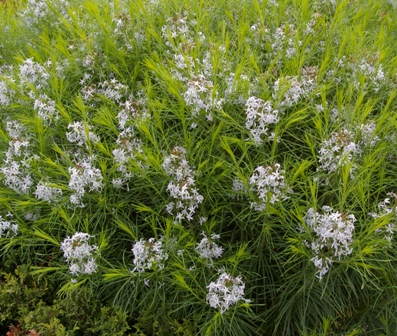Most often, when we gardeners in temperate climates think of pruning we concentrate on the late fall and winter period of the year. It is the time when the plants are dormant that we trim, shape, or otherwise modify how our shrubs and trees will grow in the following years. Yet, a large number of shrubs and trees respond very favorably to being pruned, sometimes aggressively, during the active growing period in the late spring and summer.
Many shrubs and small trees respond best to being pruned directly after they finish blooming. Some examples of these are Rhododendrons, Syringa cultivars (Lilacs), early flowering Viburnums, Rosa forms and many others. Pruning directly after bloom allows a gardener to preserve or encourage more potential blooms for the following growing season while allowing the plant in question to be shaped or downsized.
In the case of trees, summer is an excellent time to adjust the height of the understory. Overtime branches that grow in the interior of a tree’s structure often grow horizontally towards the light available at the edges of the canopy. Many of these branches are moderate to weak growers that only add weight to the load carried by the tree’s trunk. These same horizontal branches often droop towards the ground at the ends creating both a visual and spatial heaviness to the eye plus restricting the available light for plants we might want to grow beneath a tree. (Note: To avoid suckering, pruning out the top of the canopy is usually best left for when the plant of dormant,)
The extent of adjustment in height from the ground to the lowest edge of the understory will obviously vary depending on the size of the tree involved. For example I will lift the canopy by two to three feet on a Cercis canadensis ‘Forest Pansy’ (Purple leafed eastern redbud) and up to fifteen or so feet for Juglans regia (English walnut tree)*. Here in the gardens at Joy Creek Nursery I rotate our summer pruning through our trees and shrubs on about a three year cycle or as needed in my judgment.
Sometimes pruning back the ends of lower hanging branches as well as removing the secondary and tertiary branches that hang down from a main branch will lessen the weight on the branch and allow it raise up sometimes by several feet. This approach works well on smaller trees and shrubs.
One side effect of pruning back and limbing up trees and shrubs is that the overall width of the plants is often significantly reduced. This process can change significantly the exposure to sunlight for surrounding plants. The added sunlight will allow sun loving and partial sun loving plants to thrive while for shade lovers a move to a new location may be the order of the day.
Below are some examples of recent pruning in our display gardens.
Fagus sylvatica purpurea (Purple leafed Beech or Blood Beech) (Height about 25-30 feet, diameter before pruning about 25 feet while closer to 18 feet after pruning, understory height before pruning 7 feet, after pruning about 12 feet)
Rhododendron ‘Cotton Candy’ and ‘Pink Chiffon’ (A mixed planting averaging about 15 feet in height, Width before pruning 10-12 feet, after pruning 8-9 feet, understory before pruning 6-7 feet, after pruning 10-11 feet)
Fraxinus not ‘Raywood’** (Height about 25 feet, Width before pruning about 15 feet, width after pruning about 13 feet, understory height before pruning about 8-9 feet, after pruning about 15-16 feet.) I usually prune up the understory on this tree in alternating years.
Magnolia ‘Ann’ (Height about 10 feet, Width before pruning 20-25 feet, width after pruning about 15-17 feet, understory height before pruning 3.5-4 feet, after pruning 6-7 feet.) To somewhat control the lax nature of this tree habit we have staked and supported selected trunks on this plant so that we can grow other plants around and beneath it.
*I do not recommend planting English walnut trees in an ornamental flower garden. We have them in our gardens because they were the only large established trees in the area of the house when I bought the property and we established our flower beds. The tree blooms in the spring and the nuts and nut casings in the fall make a mess.
**Fraxinus not ‘Raywood’ When it came time to replace a walnut tree that died in the garden, I chose to purchase a specimen dormant Raywood ash as a replacement. Unfortunately, when spring arrived and it leafed out, the plant was certainly an ash but was definitely not Fraxinus ‘Raywood’. I like the tree and while we have had several tree experts look at the tree no one has been able to give it a positive identification. I’m certain that at some point we will get a correct identification for the tree but for now since we do not sell the plant, not ‘Raywood’ works just fine.
Mike







